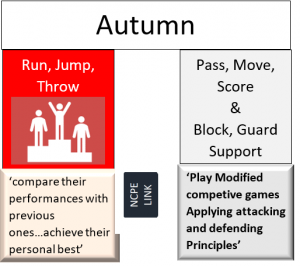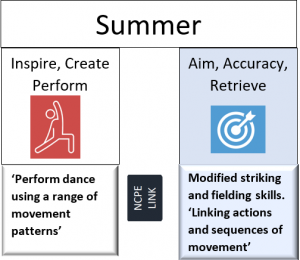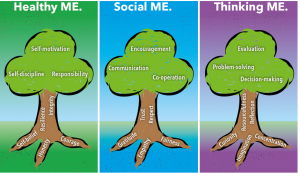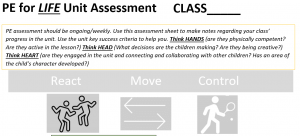
May 1, 2024, by Rupert Knight
PE is just playing sport…right?
In this post, Chris Pinnington from Brocklewood Primary School in Nottingham challenges traditional views of Physical Education (PE) as he describes the journey he and his school have been on to ensure the PE curriculum is fit for all children and staff in school.
Introduction
I’m not sure if there is any other school subject that divides opinion as much as PE does. Whether it’s remembering if the subject was loved or hated when we were at school, our beliefs on how it should be taught today, or how high on the importance list the subject is placed, PE is certainly a bone of contention.
Across schools, it is clear that some teachers love teaching PE and some teachers hate it. There are also many different approaches to teaching the subject across the schools. For example, should there be one lesson a week or two and should it be the class teacher teaching or a PE specialist or sports coach? Some schools like to teach a sport, where as other schools or colleagues would prefer to be less sport-specific and focus on skills and, for others, the emphasis is fitness.
Another area that is widely debated is how competitive PE lessons should be and whether or not PE lessons can, or even should, develop and grow other areas of the child beyond the physical aspects. It is also evident that in some cases children with a ‘sporty’ teacher have a different experience of PE than a child with a less ‘sporty’ teacher.
I have wrestled with questions like these over many years. I have tried PE scheme after PE scheme – and different approach after different approach. I have concluded that it perhaps isn’t what is being taught in the PE lessons that is the problem but it is the why and the how it is being taught across the whole school that has the biggest lasting impact on the children (and staff).
Starting our PE curriculum journey

We had a sports specific PE curriculum at the time (September 2016) and would map out the teaching to best fit around all the events and competitions that we entered. This approach finally meant as a school we would come to a competition and not finish in last place and in fact we started to do very well in some events. Our school sport offer was very good and we had a high number of children representing the school at lots of events and competitions. But, is that what PE lessons are for?
Digging deeper into our PE lessons and PE curriculum map it was clear that it was geared to achieving school sporting success – which catered for the few sportier children – rather than looking to cater for all children. Later on, in that same year I remember starting a basketball unit of work: ‘This half term we are going to be learning about basketball…’ I got a few ‘Yesss!!’ responses but also a few sighs and, looking around at the class, a few not so pleased children. It was clear that by just saying ‘basketball’, I had already lost some engagement from some in the class. Either they had already learnt to dislike this sport or, perhaps more likely, they found the ball too hard, couldn’t catch it, didn’t really know how to play, never got the ball passed to them in a game and so never got to experience any success, joy or fun.
It was from that moment on that I knew that, although our school sport offer was very good, our PE offer was only good for some children (and some staff for that matter).
PE or sport?
This of course begs the question – aren’t PE and sport pretty much the same thing? And, is it possible to not really like sport but still enjoy PE? The Association for Physical Education (AfPE) helpfully defines PE, School Sport and Physical Activity and describes the links and differences of each, summarised as follows:-
-
Physical Education is the planned, progressive learning that take places in school curriculum timetabled time and which is delivered to all pupils, including learning to move and moving to learn.
-
School sport is the structured learning that takes place beyond the curriculum within school settings, sometimes referred to as out of school hours learning with the potential to develop and broaden PE learning.
-
Physical Activity is a broad term that describes bodily movement, posture and balance. It includes all forms of PE, sports and dance but also a wide range of other activities.
Our Journey continues
Having a definition of what PE is was helpful and it was clear that our current PE offer lacked the whole school approach. It lacked the Foundation Stage to Year 6 progressive learning needed to help children achieve their best. What children were being taught depended on what the teacher liked and understood and what events might be coming up for that year group. It meant that children would have been put in situations where they need to pass, catch, jump, move, run but without necessarily having established and secured the fundamental movement patterns (the agility balance coordination) the cognitive skills and the social skills needed for such a task. Some children were being asked to run before they could walk, to use a well-known phrase. If children are put in situations where they never experience any success or joy and predominantly have a negative relationship with PE, sport, physical activity and exercise in general, it shouldn’t come as a surprise that they don’t choose to do any physical activity in their own time.
With the UK Chief Medical Officer’s recommendations that children should on average be hitting 60 minutes of physical activity every day to lead a healthy lifestyle, this is a daunting amount of time for something you don’t enjoy. The most recent research from Sport England’s active lives survey shows only 47% of children are achieving the 60 minutes a day. This will of course be for a variety of reasons and not just because some children don’t like sport. However, the health benefits of exercise towards children’s physical and mental health can’t go unnoticed. It is important that school PE leads ask themselves if their school is playing their part to increase children’s physical activity levels and whether it is doing all it can to give children opportunities to be active, make progress and to have positive experiences of PE and school sport.
It was after asking these questions of my school and doing some work on the why we teach PE that we started our journey to the model of PE, school sport and physical activity we have now.
Finding our own way
Laying good physical foundations early on in childhood will have huge benefits to that child as they grow. They will experience more success with physical activity, making it more enjoyable, making it more likely they will want to be an active child and perhaps even look for opportunities to do more physical activity (join an after-school club or join a sports team outside of school for example). Research shows that an active child is more likely to continue being active as they move through school and into adulthood. Finding a sport or a physical activity that we enjoy and can access as adults not only has huge health benefits but benefits our mental wellbeing and, on many occasions, our social lives as well. Perhaps this is why the phrase ‘PE lasts a lifetime’ has often been used in the PE world. The argument is that our experiences in PE and school sport as a child will contribute hugely to how active we are as an adult and of course, if we are an active adult will impact the rest of our lives in a variety of ways.
Whether or not you agree with the above, one thing I’m convinced of is that we will always do more of something that we enjoy, have positive experiences of and that is fun!
The biggest problem I find with lots of PE schemes of work is that they assume all children, all schools and all staff will be at a certain level. They need hours and hours of teacher ‘training’ in order for the scheme to be effective and in a large school like ours (two and a half form entry) you can never get all staff on board! The planning of course hasn’t been created with our setting and children in mind so teachers end up looking at ideas that they know just won’t work. Depending on their confidence in the subject, they either try to adapt it, end up doing something different altogether or something comes up meaning they can’t do PE that week!
I was determined to find a PE and school sport curriculum that was fit for purpose for our school, our setting, all our staff, all our children and our community. However, it soon became clear that I wouldn’t be able to find that from outside and ‘buy it in’. It was something we needed to build from within school.
I have been fortunate enough to work in the same school, leading on the same subject for 10+ years and have had a supportive leadership team who value PE and school sport and encourage their subject leaders to take risks. We know our children and families better than any PE scheme but to move away from a scheme and create a bespoke PE curriculum certainly was a risk. Our approach for many years was for myself to teach one PE lesson during teachers’ PPA time and for the teacher to teach the second PE lesson each week. We followed a sports specific PE scheme so the children might have been doing gymnastics with me on a Monday and basketball with the class teacher on a Thursday for example. This approach did mean children were given a wide PE curriculum but Ofsted’s PE Research Review says ‘this approach is a mile wide but only an inch thick’. Children’s progress and learning were thin and teacher’s confidence to teach the different sports was also very mixed.
I wanted to upskill teachers’ teaching of PE, so that they did not have to worry about it, looked forward to it and enjoyed teaching it – as this would also have an impact on how the children respond to a PE lesson. I wanted a PE curriculum that was fit for all children to make progress in their physical skills but also develop key attributes and characteristics (such as – honesty, courage, respect, decision making and communication to name a few) that impact the whole child. But most importantly, I wanted to give opportunity for both staff and children to have fun.
It has taken a few years to get to this point and there are still improvements/adaptations needed but our PE for LIFE curriculum is now in full flow!
The PE for LIFE Curriculum
Love Inspired Future Enthused
Our PE, school sport and physical activity curriculum has been designed to establish that all children belong, are given opportunities and leave our school with…
-
Love for movement that lasts a lifetime.
-
Inspired to seek out more sporting opportunities and ways to be active.
-
Future-proofed with life skills needed to perform in and beyond PE.
-
Enthused to lead a healthy active LIFE.
Our PE curriculum has been built around this intent statement and with our pupils and staff at the heart of it. The biggest change in our approach to teaching PE and what has enabled us to embed this new bespoke curriculum across school has been to remove me from the PPA timetable. Now I teach/team-teach alongside every class teacher every week.
Classes still have two PE lessons each week. The first lesson is led/taught by me, with the class teacher present and actively involved and the second is taught by the class teacher themselves. Instead of the lessons being different units, the class teacher repeats a lot of the first PE lesson. They have seen it in practice and therefore it gives them confidence to repeat elements themselves. I suggest how to move the lesson on or how to scale it back for some children, the class teacher is able to reinforce what was learnt from lesson 1 of the week and children have opportunity to repeat, practise and see for themselves progress.
This model has ensured that I know (as PE lead) what is being taught and which teachers need more support in their teaching of PE and are being up skilled in this. I also know the planning is fit for purpose, enables all children to make progress and the model has progression from Foundation Stage to Year 6.
We have scaled back the amount of coverage in our PE long term plan but now have created PE units of work that dive much deeper and enable children to work towards securing and mastering key physical skills along with lots of opportunity to develop other characteristics that are transferable across other areas of school life. There has been great reward in children repeating challenges/games and activities as this has enabled them to really embed the learning.
It was important that we covered the PE curriculum expectations and I wanted to create units of work that didn’t focus on any particular sport but where sport could still be used for the context of the learning.
It was when I came across an approach by Beyond the Physical that our bespoke PE curriculum really took off. Beyond the Physical seemed to understand my problems with PE schemes of work. Below is from their approach section on their website.
‘We do not believe in providing teachers with generic schemes of work telling you what to teach ‘week 1’, what to teach on ‘week 2’. It is impossible to predict what a child will have achieved, understood and demonstrated at any given point. What is right for your higher ability Y3 class, will not be right for the same class in a neighbouring school.’
Their approach was certainly something I could work with and their learning themes of three words (Look, Run, Avoid for example) gave great coverage of all the areas in the PE curriculum but allowed for great flexibility in what was taught. I decided to adapt their three-word approach for ourselves using some of them directly but also creating some for ourselves and started to put together our long term plans. Below is an example from Years 5 and 6.



It was also important to think about how to actively incorporate those key skills and characteristics that go beyond the physical side of PE. The Youth Sport Trust created a scheme of work called ‘My Personal Best’. We have embedded this into our PE for LIFE curriculum ensuring and planning in ways for these things to be worked on, developed and grown in the children.

(Youth Sport Trust)
-
Year 1 and 2 focus on the ‘roots’ of the trees
-
Years 3 and 4 continue to develop the roots but have opportunity to grow up the tree
-
Years 5 and 6 will be looking to develop and embed the ‘fruit’ of the trees
Moving away from a sports specific curriculum hasn’t meant that sport has been removed from PE lessons altogether – just modified to meet/challenge children where they are and adapted so all children can experience successes.
A good example of this is a unit of work created for Years 3 and 4 children called Target, Pass, Combine.
The learning focuses on aiming items at different targets or goals. We mainly used our hands – but, as we are not learning any particular sport, we are not restricted by it, so children could try different things. We played games and had challenges in pairs and small groups that focused on sending and receiving a ball to each other. Changing the way we aimed, the amount of power needed (depending on what the target was) and trying to move closer to the target was a big part of the unit. Combining the passing, moving and scoring was also central to the learning. There were lots of opportunities for all children for success in scoring and for the children to learn and experience how to play together. Their root values of concentration, curiosity, fairness and honesty were all worked on along with opportunity to grow in integrity and resilience. There was also time for the children to reflect on what went well, what didn’t and what they might try next time.
One thing that has been evident since trying this approach is how much the children need these opportunities to play and have experiences of winning well and losing well in lots of different contexts.
Assessing PE
The final part of the PE for LIFE curriculum puzzle was to have some sort of ongoing assessment. The Association of Physical Education (AfPE) have produced a helpful poster that we have used to help us create our assessments.
It was important to ensure that any sort of assessment is purposeful and not just more teacher paper work that happens at the end of term. I have rarely found an end of unit assessment worthwhile as it doesn’t give the teacher opportunity to intervene. Yet weekly assessment that then impacts the next lesson gives opportunity for a child to make progress.

Having a one-page assessment sheet, with the key success criteria of the unit on it, was helpful to ensure any assessment was focused on these outcomes.



Making simple notes each week of children’s progress can help them jump from ‘Emerging to ‘Established’ as these notes can inform next week’s lesson and teacher/TA support can be applied.
The journey continues
There are still improvements and adaptations needed but we now have a whole school approach that works in our setting. We have happier teachers who are more confident to teach PE, which is having an impact on our children. The PE lessons are meeting the children where they are in their journey of development and confidence. Our curriculum PE lessons are supported by our extra-curricular sports clubs giving children more choice in their learning and opportunities to use and develop their skills across a range of sports.
We are now a school where I can confidently say more children and staff love PE rather than hate it, where PE is certainly more than just playing sport and where the experiences that our children have in PE, School Sport and physical activity is giving them a good foundation for life.
No comments yet, fill out a comment to be the first

Leave a Reply